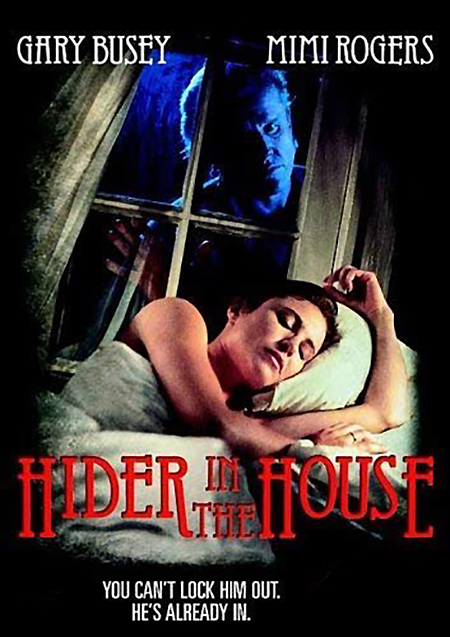
His attempts, of course, are doomed to failure, and he ends up alienating everyone and committing yet another murder, the victim this time being of Julie’s lady friends who catches him alone in the house. Other problems for Sykes include the family dog, who manages to sniff him out, and an exterminator, who nearly poisons Sykes–he offs both, and then attempts to ingratiate himself into the family by romancing Julie and protecting her son from a schoolyard bully. Sykes wastes no time in banishing Phil from the picture by surreptitiously sending Julie to a hotel room where Phil happens to be indulging his bimbo addiction. Sykes, using his post in the attic to eavesdrop on the Dyer’s conversations, understandably develops a crush on Julie, and is horrified at overhearing Phil’s whiney, self-centered benter. Said house has just been purchased by the Dyer family, consisting of the attractive Julie, her asshole hubbie Phil and their two young children. Fleeing from the scene of the crime, Sykes finds himself in a suburb and decides to move into the attic of a large two story house, sealing himself off in a small section where nobody can see him. Tom Sykes is a criminal psychopath who’s just been released from a state institution- not that his time there has curbed his violent impulses, as he attacks a man in a hotel lobby on his first day of freedom. The film, in other words, wasn’t meant to go straight to video and be quickly forgotten, but it did and it was. There were high hopes for the film, directed by up-and-comer Matthew Patrick (who previously made the now-forgotten Spanish language art film ATRAPADOS) and starring Gary Busey, just coming off a real life motorcycle accident whose affects may well have contributed to his unforgettably psychotic performance. I also read the script before production started, and remember a far different conclusion than what ended up onscreen.

I’m one of the select few who got to experience HIDER IN THE HOUSE on a big screen (lucky me) via a cast and crew screening back in 1989. One thing it definitely has in its favor is Gary Busey at his absolute craziest-and that’s saying a LOT! This doesn’t mean the film is a classic, mind you, just that it’s above average for its type. Christopher Young, Jeff Atmajian orchestrate, Jeff Vaughn engineers, Christopher Young composes, Allan Wilson conducts the Graunke Symphony Orchestra.A straight-to-video 1980s thriller that holds up better than expected. Another asset: Informative notes from John Takis. Owners of that initial release need not apply, albeit modest enhancements to sound and packaging might attract. This new mastering of the original album follows that intricate sequencing without change. This included drafting by hand a detailed flowchart of the musical sequences, divided into segments and bars, all designed to bring the listener into the mind of a tortured and violent individual juxtaposed against a more reflective and serene backdrop. When Intrada first released this score in 1990, Young personally worked at length to build a cohesive “musical narrative” of the sometimes warm, sometimes, chilling and sometimes terrifying score in large pieces rather than a just a succession of customarily short cues. But Young also creates moving family material courtesy both an exposed four-note “duet” motif for bells & vibraphone, several warm passages for strings, lean ideas for solo French horn and - especially - some haunting material for chorus based on the four-note duet motif, now broadened into a fully-rounded, emotionally saddened theme. Standing out in this regard are furious orchestral outbursts during the lengthy 18-minute “The Hider” sequence and powerful low brass-dominated rhythmic figures during “Reversing Colors”. He devotes ample time to his aggressive horror idiom.


For Young’s fans of his intense thriller voice, fear not. Amongst the coolest ideas are Young’s frequent use of bitonal chords that shift in and out, adding harmonic complexity without relying simply on dissonance. A wealth of complex string ideas, tremolos, harmonics, glissandos and other effects fill one portion of the score while chimes, percussion, flute, French horn, trombone all bring striking color to everything. Inspired writing takes listener on a musical journey through both the tortured mind of the “hider” and a sometimes idyllic, sometimes conflicted world of the married couple. Christopher Young scores for orchestra minus clarinets, trumpets, including wordless chorus. Reissue of vivid 1989 Christopher Young soundtrack for a new generation of his fans! Matthew Patrick directs, Lem Dobbs scripts, Mimi Rogers, Michael McKean play husband and wife against a troubled “hider” in the family attic, the volatile Tom Sykes, played by a dynamic Gary Busey. MUSSOLINI: THE UNTOLD STORY (2CD - REISSUE)īILL & TED'S EXCELLENT ADVENTURE (REISSUE) ROBIN HOOD: PRINCE OF THIEVES (4CD - REMASTERED AND EXPANDED)


 0 kommentar(er)
0 kommentar(er)
